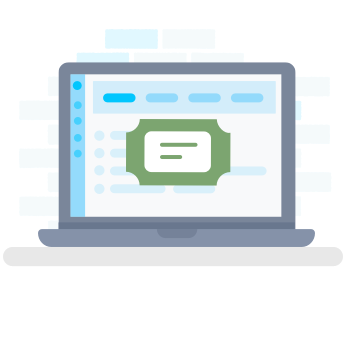The software keeps track of everyday technical issues, user queries, and IT chores in a ticket document. Each ticket acts as a repository for information needed to accomplish IT projects.
Types of IT tickets
IT tickets cover a wide range of topics. Thus, categorizing them is beneficial to customers and the IT team. Your IT department can use categorization to route tickets to the right people, streamline workflows, and identify trends.
Your IT department divides tickets into categories based on your company's needs. The following are some of the most common IT ticket types.
Feature requests: A feature request ticket is created when a company's IT services are missing a feature that would benefit users or help the company grow. Feature requests can originate from customers or any place inside the organization, and they explain what's needed and why.

Incidents: An incident is an IT term for an unforeseen outage of a computer system. This could result from a bug, an IT word for an issue that prohibits a system from executing its function as intended, or external influences like a criminal attempting to hack the system. Incident tickets document the problem so that the IT team can address it. The Information Technology Infrastructure Library (ITIL) framework outlines best practices for running an IT company.
Maintenance and service requests: IT systems need to be maintained regularly. Its users may also require services such as account password resets. A service request is made when a user needs assistance. This category of tickets keeps track of the IT team's maintenance and other normal tasks.
Business lines or teams: This system is critical If your organization sells various products or tasks are split between different departments, such as hardware and software. Organizing tickets by lines of business or teams aids in streamlining workflows and speedier resolution of issues.
Benefits of using an IT ticket software
1. Improved customer satisfaction
Customers will always run into technological difficulties. Even vital services, such as internet connection, are subject to interruptions. Customers are always satisfied if technical challenges are addressed quickly.
The IT team can use tickets to track and prioritize customer issues and quickly resolve them. When customers are happy with your IT prompt response, they are more likely to continue seeking your services.
High productivity
The IT team is more productive when it uses ticketing systems. Every IT task's information, including screenshots, documents, and other extra data needed to complete the activity, is centralized in the ticket.
A good IT ticketing software automates routine processes and makes it easy to find tickets, reminders, and reports that provide insights to help an IT staff work more efficiently.
Meet business obligations
Companies make service commitments to consumers and third parties as part of doing business. Service level agreements (SLAs) bind the business to timeliness in resolving technical difficulties.
IT ticketing solutions give you the tools you need to meet SLAs. The team's ability to work quickly and satisfy SLAs is aided by streamlined workflows, job automation and centralized data. In addition, many IT ticketing systems provide reports that demonstrate how well the team is fulfilling its business objectives.
Stages of IT ticket systems
Stage 1: Log tickets
The logging of a request into the ticketing system is the initial stage in the ticket system. Tickets come from a variety of places. A customer or employee can report a problem or file a request to the IT department.
Stage 2: Take action
Tickets are forwarded to an IT team member who is competent in resolving the issue. Tasks are sometimes performed fast, while other times, additional information is required to take action.
Stage 3: Monitor and escalate
Some tickets may stagnate while the help desk waits for a user to react to more information requests. As a result, the IT team must keep track of unresolved tickets to determine that they are resolved promptly.
Stage 4: Complete and optimize
When work on a ticket is completed, the help desk notifies clients of the outcome and closes the access. On the other hand, IT teams can obtain insight into process improvement by reviewing ticket resolution performance. Were tickets resolved per SLAs? Were the customers pleased with the outcome?
The IT ticket software is the foundation of adequately addressing consumer and company needs. There are numerous solutions for IT ticketing software. Your IT team may increase efficiency, optimize operations, and help the company prosper by using a ticketing system that suits your demands.